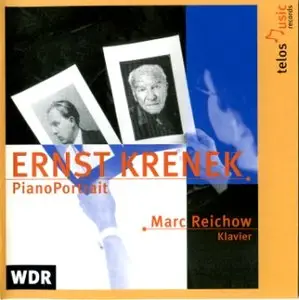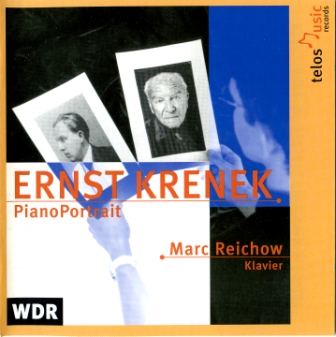Ernst Krenek - Piano Portrait (Marc Reichow)
Classical | EAC: FLAC+Cue+Log | 1 Cd, Covers + Booklet | 215 Mb
Label:Telos - Date:2000
Classical | EAC: FLAC+Cue+Log | 1 Cd, Covers + Booklet | 215 Mb
Label:Telos - Date:2000
A study of Viennese-born composer Ernst Krenek's prodigious output is rather like a study of twentieth century music in microcosm. Krenek moved with ease through the various aesthetic and stylistic changes that marked that turbulent century, taking what he considered the best features of each and fusing them into a new language all his own. Born in August of 1900, Krenek began musical training at the age of 6, and later studied privately with Franz Schreker in Vienna before enrolling for formal training with the same at the Berlin Conservatory in 1920.Tracks:
Krenek's music of the early 1920s (including the Symphony No. 1 from 1921 and the first two string quartets) is chromatically charged and rather angst-ridden; however, a 1924 trip to France, during which he was exposed to the more utilitarian, entertaining aspects of Parisian music (and Stravinsky's neo-Classicism in particular) encouraged him to explore a more accessible style. In 1927 the opera Jonny spielt auf, which fuses jazz idioms to Krenek's own brand of tonality, made Krenek a household name; the work was such a popular success that it eventually received performances in over a hundred cities in eighteen different languages.
From 1925 to 1927 Krenek lived in Kassel and Wiesbaden, serving as assistant manager of those city's operas. After returning to Vienna in 1928 Krenek began questioning his own musical aesthetic, and, upon meeting Alban Berg and Anton Webern, made a serious study of the Second Vienesse School's 12-tone techniques. By 1931, when he began composing the opera Karl V (in celebration of the unifying virtues of Catholicism, as opposed to the degeneration of Germanic society in the 1930s), Krenek was convinced of the merits of serial composition; the opera stands as his first thoroughly dodecaphonic work. Nazi officials were not oblivious to the political subtext of the opera, and the planned 1934 Vienna premiere of the work was canceled by the authorities. Krenek visited the United States in 1937, and when Hitler invaded Poland, Krenek was expelled from Austria and moved across the Atlantic permanently.
Krenek divided the remainder of his life between active composition (he remained prolific until his death in 1991) and teaching duties (first at Vassar College in New York, and later at Hamline University in Minneapolis and as guest professor/lecturer at many other American institutions). Krenek was an American citizen from 1945 on.
In the 1950s and 1960s Krenek began to explore electronic composition (e.g. Spiritus intelligentiae Sanctus for voices and electronic sounds in 1956), and also aleatoric (chance) music (e.g., the 1957 work Sestina). During the last decades of his life Krenek scrupulously avoided all compositional "trends" and "systems," choosing instead to rely on his own musical wits.
In 1992, one year after his death, Krenek's remains were transferred to the city of Vienna, where in later years he had come to be honored as befits a musician of his stature.
01. Tanzstudie op.1/2 (1920) [0:01:44.15]
02. Fuenf Klavierstuecke op.39 (1925) - 1 Allegro ma non troppo [0:01:22.53]
03. II Andante quasi adagio [0:03:26.22]
04. III Vivace [0:01:08.23]
05. IV Moderato affetuoso - attaca: [0:01:32.21]
06. V Tempo guisto - Poco piu mosso [0:01:18.72]
07. Der Augenblick (No.10 from Gesaenge des spaeten Jahres op.71) [0:04:15.33]
08. Eight Piano Pieces, op.110 (1946) - I Etude. Allegro [0:00:42.09]
09. II Invention. Andante con moto [0:01:21.45]
10. III Scherzo. Vivace [0:00:39.40]
11. IV Toccata. Allegro [0:00:45.53]
12. V Nocturne. Andante [0:02:00.30]
13. VI Waltz. Allegro [0:00:54.60]
14. VII Air. Larghetto [0:01:43.38]
15. VIII Rondo. Allegro vivace [0:01:12.32]
16. Miniatur(e), op.136 (1953) [0:02:02.45]
17. Sechs Vermessene, op.168 (1958) - I MM 60 [0:01:24.05]
18. II MM 60 [0:01:33.36]
19. III MM 60 [0:01:21.63]
20. IV MM 150 [0:04:11.42]
21. V MM cca.90 [0:02:44.07]
22. VI MM 102 - MM 60 - MM 72 - MM 60 [?] [0:01:55.42]
23. Echoes from Austria, op.166 (1958) - 1 Molto moderato [0:01:00.72]
24. 2 Allegro [0:00:58.27]
25. 3 Allegretto [0:01:25.70]
26. 4 Allegro moderato [0:00:50.55]
27. 5 Moderato [0:01:26.54]
28. 6 Allegro animato [0:01:02.39]
29. 7 Larghetto - Allegro [0:02:52.63]
30. Piano Piece in Eleven Parts, op.197 (1967) - 1 MM 120(r)/155(l) [0:02:12.06]
31. 2 MM 54 [0:00:47.18]
32. 3 MM 164(r)/120(l) [0:01:17.57]
33. 4 MM 210 [0:00:12.16]
34. 5 MM 100(r)/57(l) [0:00:24.11]
35. 6 MM 52 [0:01:29.01]
36. 7 MM 100(r)/175(l) [0:00:22.47]
37. 8 MM 56 [0:01:19.24]
38. 9 MM 120(r)/164(l) [0:01:18.04]
39. 10 MM 54 [0:01:17.68]
40. 11 MM 186(r)/144(l) [0:01:54.27]
Exact Audio Copy V1.0 beta 3 from 29. August 2011
EAC extraction logfile from 9. December 2013, 0:12
Ernst Krenek / Piano Portrait (Marc Reichow)
Used drive : TSSTcorpCDDVDW SH-S223C Adapter: 2 ID: 1
Read mode : Secure
Utilize accurate stream : Yes
Defeat audio cache : Yes
Make use of C2 pointers : No
Read offset correction : 697
Overread into Lead-In and Lead-Out : No
Fill up missing offset samples with silence : Yes
Delete leading and trailing silent blocks : No
Null samples used in CRC calculations : Yes
Used interface : Native Win32 interface for Win NT & 2000
Used output format : User Defined Encoder
Selected bitrate : 896 kBit/s
Quality : High
Add ID3 tag : No
Command line compressor : C:\Program Files (x86)\Exact Audio Copy\FLAC\FLAC.EXE
Additional command line options : -V -0 -T "COMMENT=Ripped by Tapaz9" -T "artist=%artist%" -T "title=%title%" -T "album=%albumtitle%" -T "date=%year%" -T "tracknumber=%tracknr%" -T "genre=%genre%" %source%
TOC of the extracted CD
Track | Start | Length | Start sector | End sector
––––––––––––––––––––––––––––-
1 | 0:00.00 | 1:44.15 | 0 | 7814
2 | 1:44.15 | 1:22.53 | 7815 | 14017
3 | 3:06.68 | 3:26.22 | 14018 | 29489
4 | 6:33.15 | 1:08.23 | 29490 | 34612
5 | 7:41.38 | 1:32.21 | 34613 | 41533
6 | 9:13.59 | 1:18.72 | 41534 | 47455
7 | 10:32.56 | 4:15.33 | 47456 | 66613
8 | 14:48.14 | 0:42.09 | 66614 | 69772
9 | 15:30.23 | 1:21.45 | 69773 | 75892
10 | 16:51.68 | 0:39.40 | 75893 | 78857
11 | 17:31.33 | 0:45.53 | 78858 | 82285
12 | 18:17.11 | 2:00.30 | 82286 | 91315
13 | 20:17.41 | 0:54.60 | 91316 | 95425
14 | 21:12.26 | 1:43.38 | 95426 | 103188
15 | 22:55.64 | 1:12.32 | 103189 | 108620
16 | 24:08.21 | 2:02.45 | 108621 | 117815
17 | 26:10.66 | 1:24.05 | 117816 | 124120
18 | 27:34.71 | 1:33.36 | 124121 | 131131
19 | 29:08.32 | 1:21.63 | 131132 | 137269
20 | 30:30.20 | 4:11.42 | 137270 | 156136
21 | 34:41.62 | 2:44.07 | 156137 | 168443
22 | 37:25.69 | 1:55.42 | 168444 | 177110
23 | 39:21.36 | 1:00.72 | 177111 | 181682
24 | 40:22.33 | 0:58.27 | 181683 | 186059
25 | 41:20.60 | 1:25.70 | 186060 | 192504
26 | 42:46.55 | 0:50.55 | 192505 | 196309
27 | 43:37.35 | 1:26.54 | 196310 | 202813
28 | 45:04.14 | 1:02.39 | 202814 | 207502
29 | 46:06.53 | 2:52.63 | 207503 | 220465
30 | 48:59.41 | 2:12.06 | 220466 | 230371
31 | 51:11.47 | 0:47.18 | 230372 | 233914
32 | 51:58.65 | 1:17.57 | 233915 | 239746
33 | 53:16.47 | 0:12.16 | 239747 | 240662
34 | 53:28.63 | 0:24.11 | 240663 | 242473
35 | 53:52.74 | 1:29.01 | 242474 | 249149
36 | 55:22.00 | 0:22.47 | 249150 | 250846
37 | 55:44.47 | 1:19.24 | 250847 | 256795
38 | 57:03.71 | 1:18.04 | 256796 | 262649
39 | 58:22.00 | 1:17.68 | 262650 | 268492
40 | 59:39.68 | 1:54.27 | 268493 | 277069
Range status and errors
Selected range
Filename F:\Musique\Krenek, Ernst\Krenek_PianoPortrait\Ernst Krenek - Piano Portrait (Marc Reichow).wav
Peak level 94.4 %
Extraction speed 14.4 X
Range quality 100.0 %
Copy CRC C82FB61F
Copy OK
No errors occurred
End of status report
==== Log checksum 335098F089674BB10BB6F979DE6E009AA6AAA8FAD4D7B36794BD36593EFE22B6 ====



